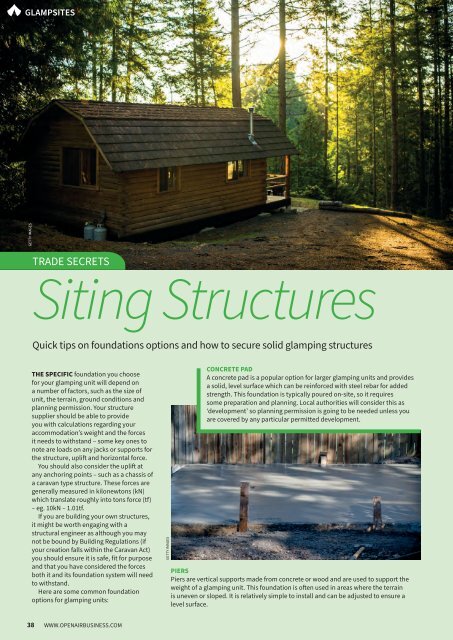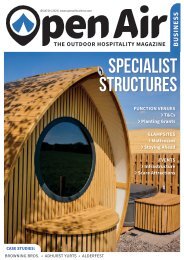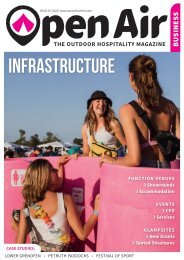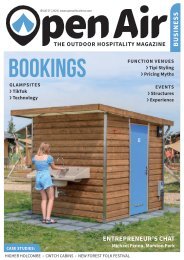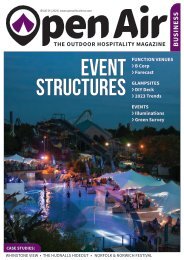Issue 56
The UK's outdoor hospitality business magazine for function venues, glamping, festivals and outdoor events
The UK's outdoor hospitality business magazine for function venues, glamping, festivals and outdoor events
Create successful ePaper yourself
Turn your PDF publications into a flip-book with our unique Google optimized e-Paper software.
GLAMPSITES<br />
GETTY IMAGES<br />
TRADE SECRETS<br />
Siting Structures<br />
Quick tips on foundations options and how to secure solid glamping structures<br />
THE SPECIFIC foundation you choose<br />
for your glamping unit will depend on<br />
a number of factors, such as the size of<br />
unit, the terrain, ground conditions and<br />
planning permission. Your structure<br />
supplier should be able to provide<br />
you with calculations regarding your<br />
accommodation’s weight and the forces<br />
it needs to withstand – some key ones to<br />
note are loads on any jacks or supports for<br />
the structure, uplift and horizontal force.<br />
You should also consider the uplift at<br />
any anchoring points – such as a chassis of<br />
a caravan type structure. These forces are<br />
generally measured in kilonewtons (kN)<br />
which translate roughly into tons force (tf)<br />
– eg. 10kN – 1.01tf.<br />
If you are building your own structures,<br />
it might be worth engaging with a<br />
structural engineer as although you may<br />
not be bound by Building Regulations (if<br />
your creation falls within the Caravan Act)<br />
you should ensure it is safe, fit for purpose<br />
and that you have considered the forces<br />
both it and its foundation system will need<br />
to withstand.<br />
Here are some common foundation<br />
options for glamping units:<br />
GETTY IMAGES<br />
CONCRETE PAD<br />
A concrete pad is a popular option for larger glamping units and provides<br />
a solid, level surface which can be reinforced with steel rebar for added<br />
strength. This foundation is typically poured on-site, so it requires<br />
some preparation and planning. Local authorities will consider this as<br />
‘development’ so planning permission is going to be needed unless you<br />
are covered by any particular permitted development.<br />
PIERS<br />
Piers are vertical supports made from concrete or wood and are used to support the<br />
weight of a glamping unit. This foundation is often used in areas where the terrain<br />
is uneven or sloped. It is relatively simple to install and can be adjusted to ensure a<br />
level surface.<br />
38 WWW.OPENAIRBUSINESS.COM


